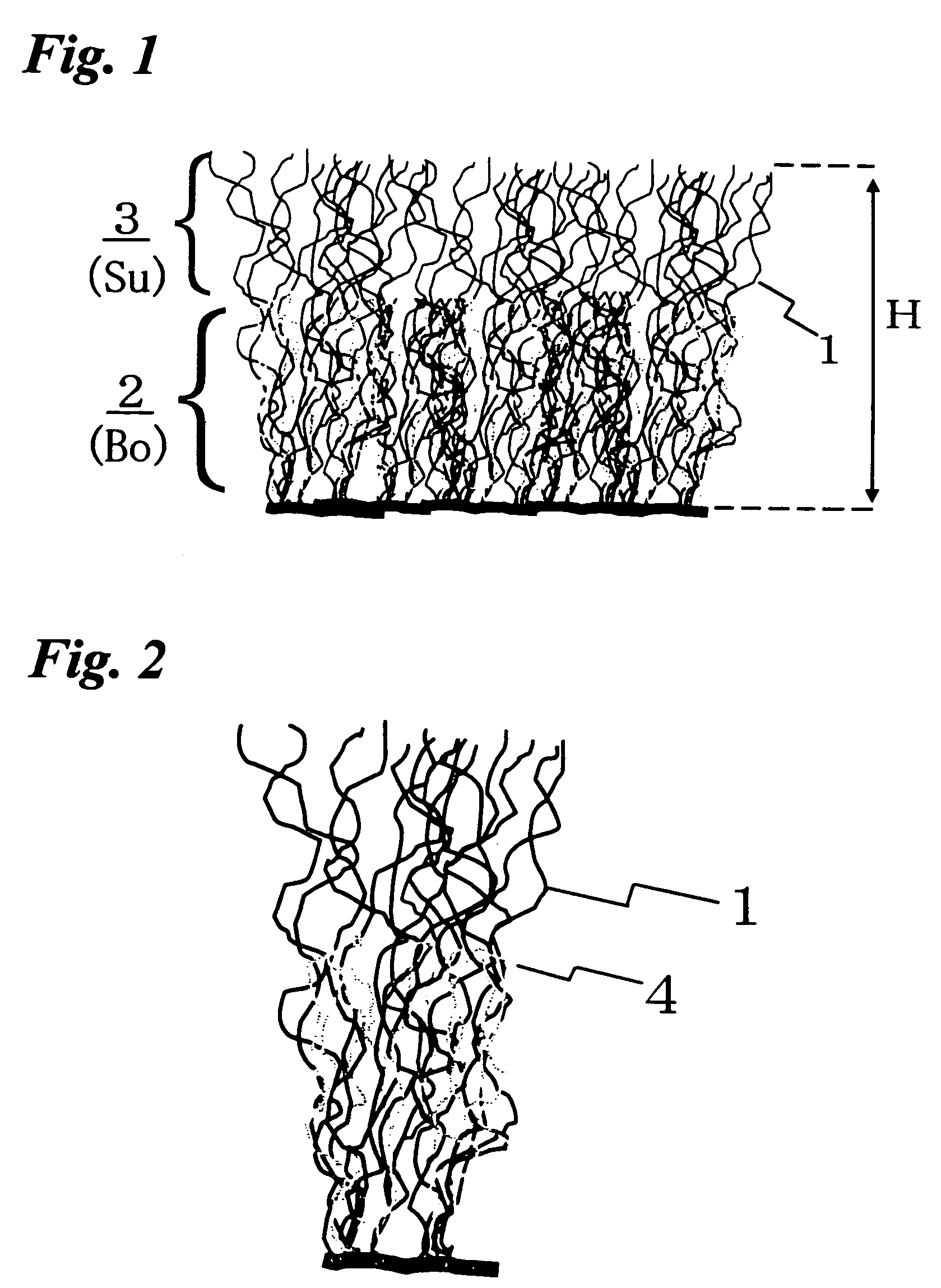Silver-knit material
a silver-knit material and sliver technology, applied in knitting, weft knitting, textiles and papermaking, etc., can solve the problems of not all pile threads are secured to the base threads, not all pile threads are buckling or shedding, and the external load is stressed, so as to reduce the amount of bulky at the surface, improve the shedding effect, and reduce the buckling fatigue or deformation
- Summary
- Abstract
- Description
- Claims
- Application Information
AI Technical Summary
Benefits of technology
Problems solved by technology
Method used
Image
Examples
example 1
(1) Preparation of Fibers
[0095]Side-by-side type composite fibers were prepared from PET chips having an intrinsic viscosity (η) of 0.72 and 0.50 at a mass ratio of 1:1 by using a spinning nozzle for spinning side-by-side type composite fibers in accordance with a customary method, and then applying a treatment at a dry heating of 150° C. for 10 min to obtain staple fibers having a fineness of 6.6 dtex, a fiber length of 51 mm and having coiled crimps. The number of crimps of the obtained staple fibers was 10 N / 25 mm.
(2) Preparation of Knitted Fabric
[0096]Using 100 mass % of the staple fibers prepared as described above, card slivers with a sliver weight of 20 g / m were obtained, which were supplied as pile threads to a 14 gauge sliver knitting machine to obtain a knitted fabric with a gross pile weight of 827 g / m2.
[0097]Polishing was carried out four times to the prepared sliver-knit material while adjusting the height of the blade to a depth of the blade about 2 mm above a level in...
example 2
(1) Preparation of Fibers
[0100]By using as a sheath ingredient, a polymer copolymerized from an acidic ingredient formed by mixing terephthalic acid and isophthalic acid at 70 / 30 (mol %) and 1,4-butanediol was used and as a core ingredient, PET chips having an intrinsic viscosity [η] of 0.72 eccentric core / sheath fusible staple fibers having a fineness of 6.6 dtex and a fiber length of 51 mm were prepared at a mass ratio of 1:1 between them in accordance with a customary method. The obtained staple fibers had coiled crimps and the number of crimps was 18 N / 25 mm after a treatment at dry heating of 150° C. for 10 min.
[0101]Then, homogeneous fibers were prepared from PET chips having an intrinsic viscosity [η] of 0.72 by using a spinning nozzle for spinning homogeneous fibers of a circular cross section in accordance with a customary method to obtain staple fibers having mechanical crimps with a fineness of 6.6 dtex and a fiber length of 51 mm. The number of crimps of the staple fiber...
example 3
(1) Preparation of Knitted Material
[0105]60 mass % of staple fibers having coiled crimps used in Example 1 and each 20 mass % of eccentric core / sheath type staple fibers and staple fibers having mechanical crimps used in Example 2 were used and mixed to obtain card slivers having a sliver weight of 22 g / m, and they were supplied as pile threads to a 14 gauge sliver-knitting machine to obtain a knitted material having a gross pile weight of 853 g / m2.
[0106]Polishing was applied repetitively by four times to the thus obtained sliver-knitted material while controlling the blade height to about 2 mm depth above a level where the blade was in contact with a ground portion and then operation was carried out backing with the acrylic resin on the bottom by a dry heat treatment at a setting temperature for hot blow of 180° C., brushing the surface and then aligning the threads to obtain a sliver-knitted material with a pile height of 18 mm in this order.
(2) Manufacture of Paint Roller
[0107]Us...
PUM
| Property | Measurement | Unit |
|---|---|---|
| height | aaaaa | aaaaa |
| height | aaaaa | aaaaa |
| height | aaaaa | aaaaa |
Abstract
Description
Claims
Application Information
 Login to View More
Login to View More - R&D
- Intellectual Property
- Life Sciences
- Materials
- Tech Scout
- Unparalleled Data Quality
- Higher Quality Content
- 60% Fewer Hallucinations
Browse by: Latest US Patents, China's latest patents, Technical Efficacy Thesaurus, Application Domain, Technology Topic, Popular Technical Reports.
© 2025 PatSnap. All rights reserved.Legal|Privacy policy|Modern Slavery Act Transparency Statement|Sitemap|About US| Contact US: help@patsnap.com



